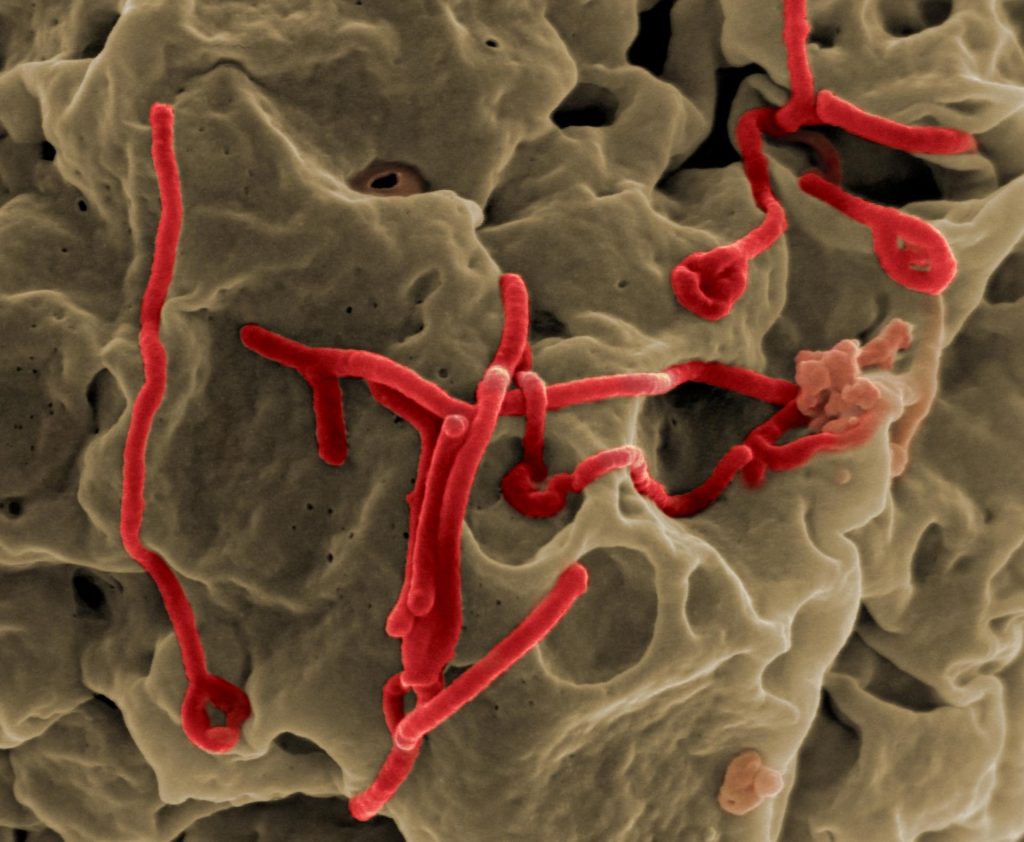
LA JOLLA, CA—To treat Ebola virus infections, researchers are taking a close look at a key piece of the virus: polymerase.
Polymerase is a viral protein that directs how Ebola virus replicates its genome as it infects new hosts. Drugs that target polymerase could potentially treat Ebola virus infections and save lives.
Now scientists at La Jolla Institute for Immunology (LJI) and Scripps Research have found a promising strategy for stopping Ebola virus polymerase. The researchers discovered that Ebola virus polymerase hijacks a cellular protein called GSPT1. Their investigation reveals that an experimental drug that targets GSPT1 for degradation can also halt Ebola virus infection in human cells.
“To target the virus, we need to know which tools it uses,” says LJI President and CEO Erica Ollmann Saphire, Ph.D., who co-led the Cell Reports study with Scripps Research Professor Juan Carlos De La Torre, Ph.D., and University of Texas Medical Branch (UTMB) Professor Alexander Bukreyev, Ph.D.
The problems with Ebola polymerase
Many viruses encode their own polymerase. In fact, antiviral therapies designed to treat viruses such as hepatitis C (Sofosbuvir/SOVALDI→) work by blocking viral polymerase.
But targeting Ebola virus polymerase has proven tough. Back in 2018, researchers tested a broad-spectrum antiviral candidate called remdesivir/VEKLURY→, which acts as a nucleotide decoy to get incorporated into the viral RNA genome and stop viral polymerase. Unfortunately, in a Phase 3 clinical trial, treatment with remdesivir did not make a difference in mortality for Ebola virus disease patients.
The major challenge in developing drugs directly against Ebola virus polymerase is that scientists have not solved its atomic structure. Without this information, researchers cannot move forward with structure-based drug design.
For the new study, LJI and Scripps Research Graduate Student Jingru Fang and her colleagues tried a new strategy. Instead of targeting Ebola polymerase directly, the researchers aimed to target cellular proteins critical for viral polymerase to function.
“We were trying to identify the population of cellular proteins that interact with this essential machinery encoded by the virus,” says Fang.
Catching polymerase in the act
The team found that polymerase succeeds by biding its time in host cells.
Early in infection, it appears that host cellular proteins are in defense mode against Ebola virus polymerase and the viral genetic material. “This presents additional hurdles for polymerase,” says Fang. “Polymerase is navigating through this hostile complex intracellular environment while focusing on its primary task: to make abundant copies of viral genomes and mRNAs.”
The team found two cellular proteins, called GSPT1 and UPF1, that interact with Ebola virus polymerase and restrict Ebola virus early in infection. The immune system is fighting back.
But then comes the plot twist. Later in infection, Ebola virus polymerase gains a foothold in cells by hijacking a subset of cellular proteins from the host antiviral defense line to promote viral replication. “To our surprise, Ebola virus can subvert host restriction imposed by GSPT1 and UPF1,” says Fang.
The researchers found that Ebola virus polymerase leverages host protein GSPT1 to positively regulate viral transcription—a process the virus uses to convert its genetic material into instructions for making viral proteins.
“You can imagine GSPT1 acting as a stop sign to inform the polymerase stop precisely at each intersection. Without the stop sign, viral transcription no longer follows the correct order, which has a negative impact on viral protein production,” says Fang.
“We weren’t expecting to see this,” says Fang. “The virus hijacks this protein and makes it do something different than its normal job in cells. To our knowledge, this is the first time GSPT1 has been linked to viral infection.”
These insights were made possible thanks to an enzyme, called split-TurboID, which is a biotin ligase engineered by the lab of Stanford University Professor Alice Ting, Ph.D. This special enzyme, once fused to Ebola virus polymerase, enables the polymerase to add a molecular tag to any other protein it interacts with. By fishing out proteins that contain this unique tag, researchers could map out the complex series of Ebola virus polymerase-host protein interactions.
A new route for interfering with Ebola virus infection
The researchers wanted to see if they could target GSPT1 to suppress Ebola infection. To test this, the LJI team partnered with their long-term collaborator, the UTMB research group led by Professor Alexander Bukreyev, Ph.D., who could carry out experiments with live Ebola virus in a high containment research facility.
The small molecule CC-90009, originally developed as a drug candidate for treating acute myeloid leukemia patients, targets GSPT1 for degradation. The researchers found that treatment of Ebola virus-infected cells with CC-90009 interfered with the activity of the virus polymerase and inhibited Ebola virus multiplication. Fang says follow-up research with primary cell lines and proper animal models should be done to provide further evidence for repurposing CC-90009—or similar therapeutic strategies to cure Ebola virus disease.
“This study shows there are new targets we can go after to treat Ebola virus infection,” says Fang.
Additional authors of the study, “Functional interactomes of the Ebola virus polymerase identified by proximity proteomics in the context of viral replication,” include Colette Pietzsch of UTMB, George Tsaprailis and Gogce Crynen of Scripps Research (Florida), and Kelvin Frank Cho of Stanford University.
The study was supported by institutional funds of La Jolla Institute for Immunology, institutional funds of University of Texas Medical Branch, a Donald E. and Delia B. Baxter Foundation Fellowship, the National Institutes of Health (S10OD021831), and the National Institute of Allergy and Infectious Diseases (AI125626, AI128556).
DOI: 10.1016/j.celrep.2022.110544
###





